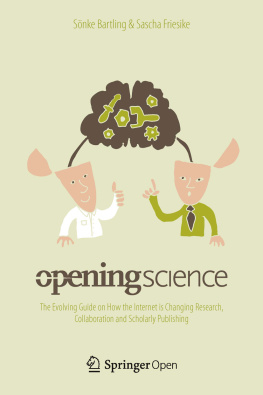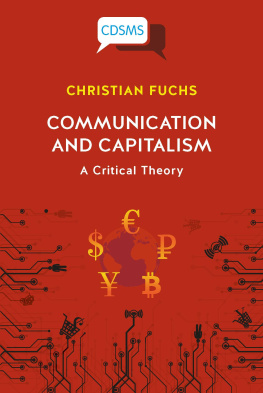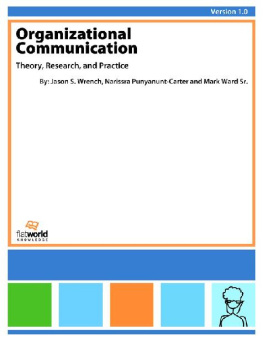EBSCOhost - printed on 11/28/2021 2:16 PM via . All use subject to https://www.ebsco.com/terms-of-use
The Deutsche Nationalbibliothek lists this publication in the Deutsche Nationalbibliografie; detailed bibliographic data are available on the Internet at http://dnb.dnb.de.
EBSCOhost - printed on 11/28/2021 2:16 PM via . All use subject to https://www.ebsco.com/terms-of-use
Recontextualized Knowledge
Introduction: A Rhetorical View on Science Communication
Markus Gottschling
Olaf Kramer
From Public Relation to Participation. Developments in Science Communication
Science needs communication to stay connected to society and to find answers to future challenges. This statement may sound like a truism, but universities and research institutions have yet to fully realize its consequences and implications. Traditionally, science communication relied on knowledge deficit models (cf. ; Akin/Scheufele 2017). Defining science communication as a process of monodirectional transmission, such models based themselves on the assumption that the public possesses a knowledge deficit which the dissemination of knowledge can erase, preferably through mass media. After all, so the reasoning goes, the public should have an interest in scientific research, so the more scientists and scientific institutions send, the more they will eventually listen. At the root of knowledge deficit models lies an ignorant presupposition. Namely, that the onus rests on non-specialists to develop their own science literacy, informing themselves about scientific discourse and its societal consequences: the facts speak for themselves. If the public does not accept or recognize these facts, then the failure in transmission is blamed on journalists, irrational public beliefs, or both (Nisbet/Scheufele 2009). Operating within the knowledge deficit model, scientists could ignore that science literacy only plays, as Nisbet/Scheufele (2009) describe it, a limited role in shaping public perceptions and decisions, and consequently overlook that their own efforts in communicating to the public might be part of the problem.
In recent years, however, science communication has experienced significant development, becoming an umbrella term for a diverse, heterogenous and rapidly growing discipline in theory and practice (cf. ). Such a broad definition then encompasses not only traditional forms of institutionalized science PR, but also academic conferences and colloquia, Twitter threads, slack channels, science festivals, science slams, and science journalism.
Accordingly, a model which focuses more on explanation, participation, and popularization of and in science, and aims at creating Public Understanding of Science and Humanities (PUSH), was proposed in the UK as early as 1985 (cf. The Royal Society 1985). This spawned international offshoots such as, for example, the PUSH Memorandum (Wissenschaft im Dialog 1999), issued by Germanys largest scientific institutions, which led to the creation of the science-PR initiative Wissenschaft im Dialog (Science in Dialogue). In recent years, Public Engagement with Science and Technology (PEST) has emerged as a more comprehensive approach to intensifying the contact between science and society (cf. NCCPE 2010). The development of PEST methodology has changed the objectives of science communication. Rather than promoting, showcasing or advertising institutes, technologies or specific research results, scientists aim to establish a procedural understanding of research. PEST formats build public trust by emphasizing the expertise, benevolence, and integrity of communicators (cf. ).
The aforementioned paradigm-shift from explanation and knowledge transfer to dialogue and participation has, in the last decade, been mirrored in the blossoming international research on science communication and its methodology (e.g., ). With the turn from the knowledge deficit model toward a more participatory approach, modeling also began to take social, media, and political contexts into account. As a consequence of this development, Akin/Scheufele (2017) promoted a third model, focusing on science communication in context.
Science Communication as Rhetorical Communication
Science is assuming an increasingly active role within the social and political context which Akin/Scheufele (2017) invoke. Today, science influences and changes social and political discourses and is itself changed and influenced by them. Because of this, science finds itself in a legitimation discourse in need of public trust (cf. ).
This development places the communication of scientific insights, discourses, and processes in the context of political communication (cf. ). Science communication as political communication must introduce scientific discourse into social and political debates to inform public discourse on possible future developments in society. However, by entering public debate, science is entering a field that is not simply driven by neutral information and rational decisions, but by group-specific interests, personal motivations, and affective reactions. This is where rhetoric as a research discipline comes into play, because at its heart lies persuasion through communication in the face of conflicting interests and, often enough, conflicting evidence.
[W]e translate smeion as signum [a sign, MG/OK] though some have used indicium (indication) or vestigium (trace) instead. It is that from which something else is inferred, for example murder from blood. But it may be the blood of a sacrificed animal that has got on to the clothes, or just a nosebleed: a man whose clothes are bloody has not necessarily committed homicide. ()
These considerations by the Roman rhetorician Quintilian in the fifth book of his Institutio Oratoria are not only instructive for forensic rhetoric, but also for obviating the necessity of persuasively linking facts and their implications. Forensic argumentation is dependent on evidence, on reliable signs that can prove the position of the prosecutor or the defense attorney. Yet, as Quintilian points out, only in very rare cases do signs allow a unanimous interpretation. They are precarious and often will not convince the other side spontaneously. Signs are not mechanical instruments of persuasion, though one side might present and treat them in such a way. They might refer to a certain fact, yet their reference function to this fact is insecure as is its interpretation, which always depends on the perspective from which one evaluates the fact.
We can learn a great deal from the difficulties of arguing in front of a court when it comes to science communication. When scientists present their findings arising from specific methods, which have proven to create valid results, they tend to ignore different perspectives addressees might take and how this influences the ways in which they perceive facts. The situational context of communication can lead to different evaluations and assessments of facts, which are a defining characteristic of forensic rhetoric. The rigorous methods and structures of scientific research are capable of producing validated facts. Yet, this rational point of view ignores the cultural and psychological factors which influence the way people think.







